telegraphic codes and message practice
scanned code directory
A. C. Baldwin, pastor, telegraph lexicographer, poet
note —
This is a reformatted but otherwise unedited piece from my long-neglected — abandoned, rather — catatan blog.
telegraphic code incunabula
writing for the telegraph, writing for the pulpit
religious codes, and a conclusion
A. C. Baldwin (1804-1887) : life and works
publications
A. C. Baldwin’s Traveler’s Vade Mecum (1853) interests me because 1 it is early; 2 it has a delightful mix of phrase matter; and 3 its compiler also wrote poetry and an index rerum
-like classified list of themes, authorities and scriptural passages for use in composing sermons.
The full title is The Traveler’s Vade Mecum; or, Instantaneous Letter Writer by Mail or Telegraph, for the convenience of persons traveling on business or for pleasure, and for others, whereby a vast amount of time, labor, and trouble is saved. Note that neither economy nor secrecy are given as objectives for the code; it is conceived as an aid to writing.
It takes its place among the incunabula of the form, when telegraphic codes were forking off from their signal book predecessors. One sign of its signal code derivation is its organization into two sections (signal codes were typically ordered in this way, for two, three and four signals, for time-critical, classified phrase, and vocabulary sections, respectively). Pages 13-32 provide phrases under the departments
of traveling, home, clergymen, and commercial. The fifth department, for miscellaneous, is much the largest and runs from page 33 to the end of the 300-page book.
The code offers 8466 numbered phrases. A sense of the whole might be gained from this selection, drawn from each of the five departments —
| 1 | I send you by mail a book, a duplicate of which I have with me, whereby I shall be enabled to let you hear from me often with very little trouble. |
| 2 | Please to accept of this book, by means of which I hope to have the pleasure of exchanging thoughts with you frequently. |
| 29 | I am in one of the famous ventilated cars which professes to exclude the dust, but in my opinion it is a great humbug. |
| 37 | The scenery on the banks of the river is perfectly enchanting. |
| 92 | Inquire for my umbrella which I left at . . . |
| 134 | This is a place under a good moral influence. |
| 133 | This is an immoral place. |
| 214 | Composed and entirely resigned to the will of God. |
| 312 | I shall be absent next Sabbath, and wish the committee to see to the supplying of the pulpit. |
| 387 | The news from Europe has served to depress the price of stocks. |
| 1697 | When does college term begin? |
| 2253 | Buy any quantity (or . . . bales) of cotton as speedily as possible. |
| 3476 | I would like to make arrangements with you to publish another edition if agreeable. |
| 6135 | Our friend . . . . has fallen in love with a pair of bright eyes, and is thought to be past recovery. |
| 6483 | You may send me forthwith cut nails of the following description and quantity, viz., . . . . |
| 7571 | You will rue the day if you do. |
| 7574 | On the road to ruin with railroad speed. |
| 7579 | There is a delightful rural prospect from this place. |
| 8009 | . . . . is a notorious swindler, and not the least confidence whatever can be placed in him. |
| 8450 | You are quite too young to think of any such thing. |
| 8466 | The thermometer is ... degrees below zero. |
In general, there is greater depth of phrase matter within the topics of the first four departments, than is the case for the miscellanous section. The compiler likely had little knowledge of commercial topics — any quantity of cotton? at what classification? — and phrases under that heading might better have been distributed in the miscellaneous section.
An example is given of how the Traveler’s Vade Mecum might be used —
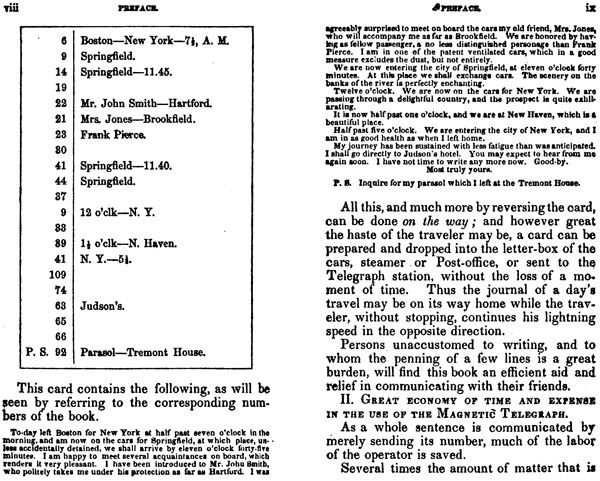 |
|
| A. C. Baldwin, The traveler’s Vade Mecum or Instantaneous Letter Writer (1853) | |
Here, the message is written on a card, not a telegram blank. Figures in the left column indicate phrases; words (place and personal names, times) at the right are qualifications of those phrases. The virtue here seems to be in writing, not in economy of sending. The example and its translation are followed by this dubious assertion: Persons unaccustomed to writing, and to whom the penning of a few lines is a great burden, will find this book an efficient aid and relief.
One can form one’s own opinion of this, by perusing the phrases offered in these two pages from the Home
and Clergymen’s
departments —
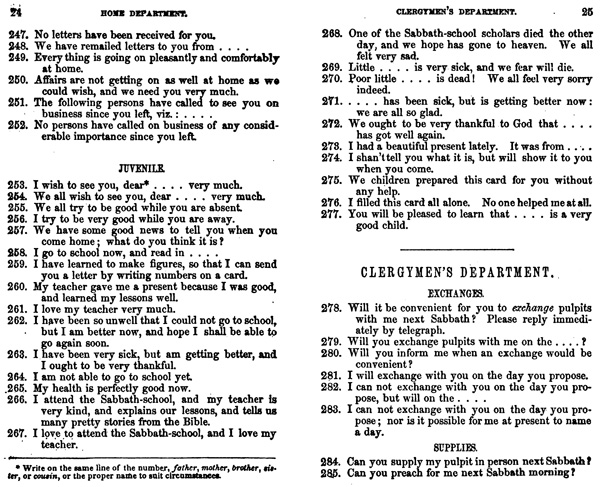 |
|
| A. C. Baldwin, The traveler’s Vade Mecum or Instantaneous Letter Writer (1853) | |
I doubt that this code found many (or even any) users. The phrases in its travel department are too dependent upon a somewhat limited script. Later codes with a large phrase vocabulary devoted to travel, offer more expressions about meetings, being late, missing connections, sending and receiving money, and the like. Overall, Baldwin’s phrases are an uneven mix of very personal and over-detailed observations. And too, the combination of personal (and even sentimental and romantic), business and other very diverse content in the phrase offerings means that nothing is gone into deeply. Yet all of these shortcomings make this an interesting read; the book is an early draft in a genre that would develop rapidly, and take different forms, over the next 70 years.
The Google scan is of a copy at NYPL (which knows the compiler as A. C. Balwin
); here is access to the HathiTrust version of the same NYPL scan. I have not yet examined a physical copy of the code, which is 16cm tall according to OCLC; other copies are at Trinity College (Hartford, Connecticut) and Cambridge University.
telegraphic code incunabula
The traveler’s Vade Mecum appeared only a few years after the introduction of the electro-magnetic telegraph in regular service in the United States (mid 1840s), run on Morse’s telegraphic alphabet. The codes were a new genre, one that would evolve — and diversify in form and subject domains — over the next few decades. Some of the earlier published codes have the flavor and tentativeness of first drafts.
In addition to 1 Traveler’s Vade Mecum, these early codes — leaving out purely marine signal codes — included F. O. J. Smith his 2 The Secret Corresponding Vocabulary; adapted for use to Morse’s Electro-Magnetic Telegraph and also in conducting written correspondence, transmitted by the mails, or otherwise (1845); Henry J. Rogers his 3 The Telegraph Dictionary, and Seamans’s Signal Book, adapted to signals by flags or other semaphors; and arranged for secret correspondence, through Morse’s Electro-Magnetic Telegraph: for the use of commanders of vessels, merchants, &c. (Baltimore, 1845); two codes by John Wills, 4 his Electro-Magnetic Telegraph Vocabulary, or, condensing correspondent, designed to communicate commercial and other general intelligence, in abbreviated form and at small expense (Baltimore, 1846); and 5 his Telegraphic Congressional Reporter (Baltimore, 1847); and Alexander Jones, 6 his A System for Condensing or Abbreviating Communications for Transmission by Magnetic Telegraph (New York, 1848). (I give their extended titles because of the self-descriptions these usefully provide.) Of these six, only two — Jones 1848 and Wills 1846 — employ codewords; Traveler’s Vade Mecum and the others employ figures or other cipher constructs.
Baldwin admits to having undertaken a project whose ultimate scale, if known at the outset, would have discouraged the attempt. He would need to generate and organize phrase matter, against the sense of the impossibility of anticipating the wants of every body, and the difficulty of deciding what phrases will be most needed.
How much about travel? How much about marriage, or cotton or failure? And how many senses under each heading (of failure, say), and what should the key words be, for phrases that might conceivably fall under more than one?
What models might a scholarly pastor have had available? Signal codes? Baldwin notes in his preface that whilst engaged in the project, Rogers’s Telegraphic Dictionary (1845) had appeared, and so he may have worked with that. He acknowledges that Rogers anticipated
several of the features in his own code, but observes that Rogers’s code was designed for the marine service
, and not for general correspondence like his own. Models or none, Baldwin built a dictionary of 8,466 numbered and classified phrases — testament to discipline, obsession, perhaps a hope of exploiting the new telegraphic technology in order to generate supplemental income.
I’ve already mentioned flaws in the code, from which it derives some of its charm today. Some phrases might have been taken from an etiquette book, and even from poetry —
| 6089 | It is a long story ; too long to telegraph. |
| 8019 | It is very tedious, and hard to be endured. |
| 8111 | I am not so tired so as to suffer any inconvenience. |
| 8174 | It is unjust, and not to be allowed. |
| 8175 | It is unkind as well as unchristian. |
| 8362 | I advise you by all means to take a wife, provided you can find one worthy of you. |
These phrases bring to mind the poetical effusions found in John L. Winnea’s Cryptography (San Francisco, 1881). That document (and associated US Patent 294,175 of 1884 for a Cryptographal Table
) focuses on blank tables and codewords, but also provides a single page of phrases
of progressively baroque construction :
| Against my judgment and inclinations | |
| Avowing the utmost respect and desire to | |
| Have been unfortunate in his intercourse with the world | |
| Have put in circulation some of my trifling letters | |
| Delicacy and pride, therefore, forebade any advances on my part | |
| The vivacity, the ingenuousness, and the sensibility of her sex and her country | |
| By enjoying, I can impart happiness so exquisite, my heart, my disposition, my feelings, my affections, are still the same, glowing with the same warmth |
Read further for another instance of phrases coming unmoored from the mundane purposes of the code that contains them (Andrew Hallner’s Scientific Dial Primer of 1912). There were also, of course, more intentionally literary (witty, ironic, etc.) riffs on telegraphic codes. But I digress.
Other specialized phrase dictionaries were available for literary and presumably other composition. Two examples are Thomas Dolby’s The Shakespearian Dictionary (London 1832) and J. Hain Friswell, his Familiar words, subtitled An index verborum or quotation handbook
(London, 1865). The latter is later than our period, but may have had predecessors. Books of this sort may have provided models for Baldwin; certainly, they coexisted with his and others’ codes, all of which might be set under the heading classified phrase dictionary. Roget’s Thesaurus of English Words and Phrases, Classified and Arranged so as to Facilitate the Expression of Ideas appeared in 1852, just one year before The Traveler’s Vade Mecum.
An additional parallel, though not model, for the The traveler’s Vade Mecum was model letter books. Sporting titles like The New Letter Writer (1853), the The Fashionable American Letter Writer (1833, here), and The Compleat Letter Writer (1756), these combined model letters with rules of etiquette, and were a long-established genre in 1853. Baldwin provides not letters, however, but classified phrases for letter production.
As for subject domain expertise? Wills (1846 and 1847) knew commodities, trade and politics; Jones (1848) knew commodities. J. S. Buell, compiler of Mercantile Cypher for Condensing Telegrams (Buffalo, 1860), knew canal and rail transportation.
Baldwin was not an expert in any professional subject domain apart from pastoring. But his labor in composing sermons, and the analytical skills he had employed in developing a classified index of themes and texts for the pulpit, may have specially equipped him for developing a telegraphic phrase dictionary.
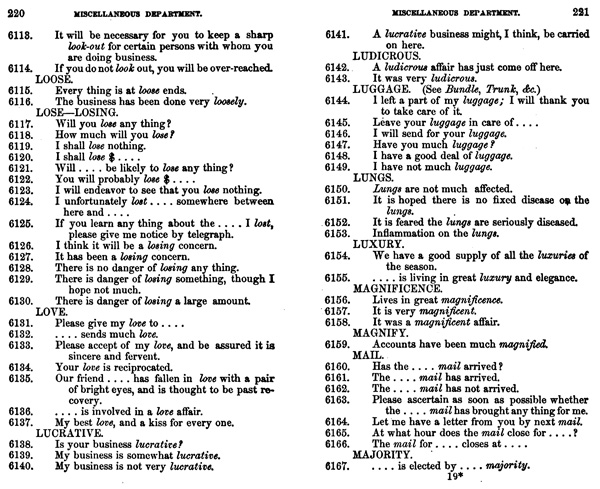 |
|
| A. C. Baldwin, The traveler’s Vade Mecum or Instantaneous Letter Writer (1853) | |
Writing for the telegraph, writing for the pulpit
Writing for both the telegraph and the pulpit involve formulaic composition. The sermon is the more literary form, of course, one that requires the full repertoire of rhetorical and literary devices, and in which economy of expression is no virtue, save in the service of higher purpose with regard to the listener’s soul. But construction of telegraphic messages, and of sermons, involves identification of themes, selection of texts, assembly of messages. For the pulpit, the texts came from scripture, and there existed a variety of aids for exploiting that reservoir, including concordances, but also books with titles like Pulpit Outlines, Pulpit Sketches, Helps from the Pulpit; or Sketches and Skeletons of Sermons, Pulpit Orator, Studies for the Pulpit; Containing Skeleton Sermons, Biblical Illustrations..., and so on. The preacher might also subscribe to The Preacher and Homiletic Monthly and other periodicals. And he would also have maintained his own index rerum, perhaps that blank book published by John Todd.
Baldwin’s Themes for the Pulpit, being a collection of nearly three thousand topics with texts... (1841) was one such tool. It was designed primarily as an aid to selecting a subject, and a few pertinent passages from scripture; it provides no skeleton
upon which to build a sermon, and still less, anything like model sermon.
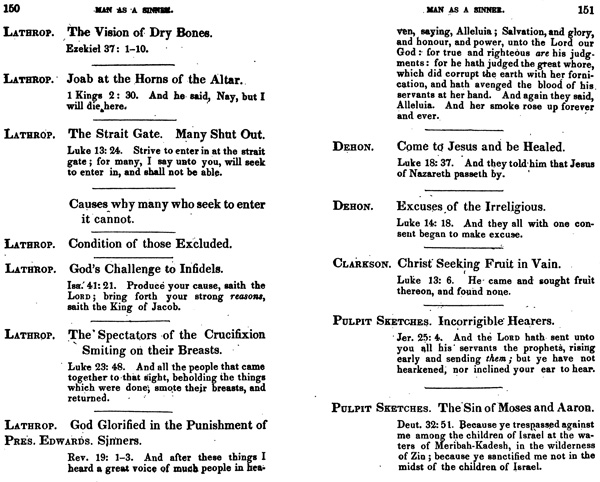 |
|
| A. C. Baldwin, Themes for the Pulpit, being a collection of nearly three thousand topics with texts... (1841) | |
As is evident from the page spread shown above, it provides subjects, texts, and the names of divines — but not further bibliographic information — in a thematic (or thesauric) order; the topics are not arranged in the order in which they should follow each other in a Theological System.
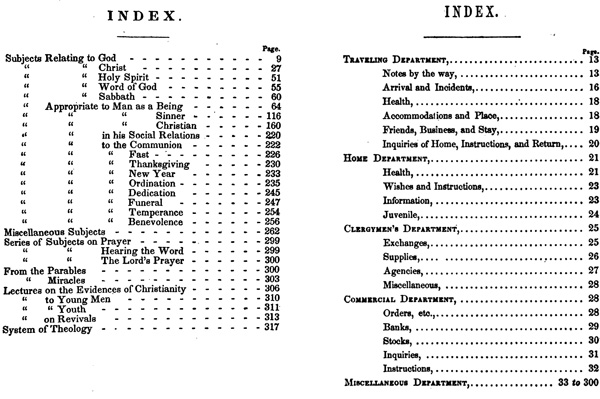 |
|
| left: table of contents, A. C. Baldwin, Themes for the Pulpit (1841); right, table of contents, The traveler’s vade mecum or Instantaneous Letter Writer (1853) | |
Take the first heading, of subjects relating to God. Remove the authorities and scriptural passages, and what remains is a more quickly scannable, panoptical view of subjects —
The Being of God proved from the Frame of the World.
The Being of God proved from the Frame of Human Nature.
The Being of God proved from Universal Consent.
The Being of God proved from Supernatural Effects.
Eternity of God.
Omnipresence of God.
The Grandeur of god.
The Greatness of God’s Wisdom and Power.
The Holiness of God.
The Compassion of God.
The Incomprehensibility of God's Mercy.
The Severity of God.
The Patience of God with Wicked Nations.
The Long-Suffering of God with Individuals.
God the only Object of Fear.
Baldwin may have derived these Themes for the Pulpit from his notes of reading scripture and other authorities, entered into an index rerum or something like the same blank book he assumes his readers maintain.
Baldwin distinguishes his production from the many pulpit outlines,
sketches
and skeletons
targeted at indolent and uninspired pastors. He characterizes this volume as merely supplemental to the index rerum that his readers surely maintain —
It is not pretended that this book contains all those subjects which are profitable for pulpit discussion. It is presumed that every Pastor keeps a blank book in which he enters from time to time topics appropriate to the spiritual wants of his people, which are suggested to him in his reading, conversation, and pastoral labours. This collection is by no means intended to supersede the necessity of his keeping such a book. The blank leaves bound up with this volume are designed for him to use for this purpose. In this part of the book he can add subjects as they occur to him, arranged either according to the plan of the preceding pages, or according to a plan of his own.
And indeed, 80 unnumbered and blank pages follow the last page bearing print. Those blank pages are unmarked in the the NYPL/Google scan.
religious codes, and a conclusion
Telegraphic codes were compiled for every realm, religion no exception. The most common example is missionary codes; The China Inland Mission Private Telegraph Code (Shanghai, 1913) is described, and onward links provided, here.
There also existed codes for trade in ecclesiastical vestments and equipment, and religious publications. The Salvation Army issued a code in several editions; see a description at the website of SA International Heritage Center, and a delightful article by Wesley Harris, Souvenirs of Salvationism 1,
Journal of Aggressive Christianity 40:256 (December 2005 – January 2006): 50 (pdf here (accessed 16 July 2007).
And then there is Andrew Hallner his The Scientific Dial Primer Containing universal code elements of universal language, new base for mathematics, etc. (San Francisco: Sunset Publishing House, 1912), an impractical but religious-based code that reads like an epistolarly novel. A description and onward links can be found here.
But to conclude on A. C. Baldwin, who was no crank.
Baldwin in his life, and in his The traveler’s vade mecum and his Themes for the Pulpit, embodies an intersection of several of my own longstanding interests : telegraphic codes, index rerum (and other commonplace and notational systems), poetry, and deafness. His Themes for the Pulpit is a refined and analytical classification of a large body of material, both from scripture and from other authorities, and its compilation would have taken the same attention to textual detail, and overall structure, that undergird any telegraphic code. His code is remarkable for its ambition and scope of subjects: I presume it was not a financial success, but it remains a fascinating instance of lexicographic art. I must leave this essay in its present state, for now, but expect to augment and revise it as I investigate Baldwin and his work — including his duties at the Deaf and Dumb Asylum in Hartford — more closely.
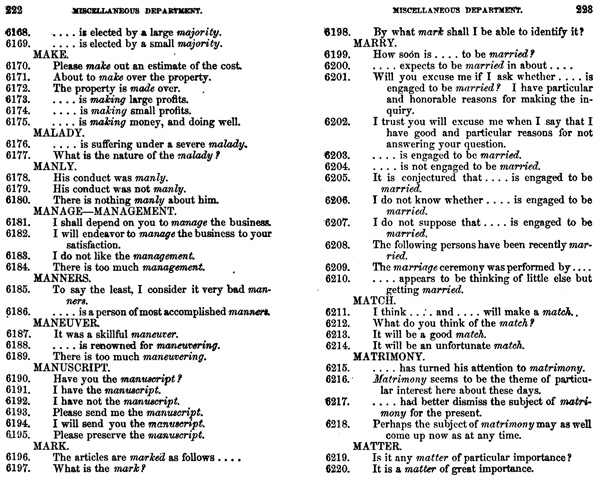 |
|
| A. C. Baldwin, The traveler’s vade mecum or Instantaneous Letter Writer (1853) | |
Abraham Chittenden Baldwin, life and works
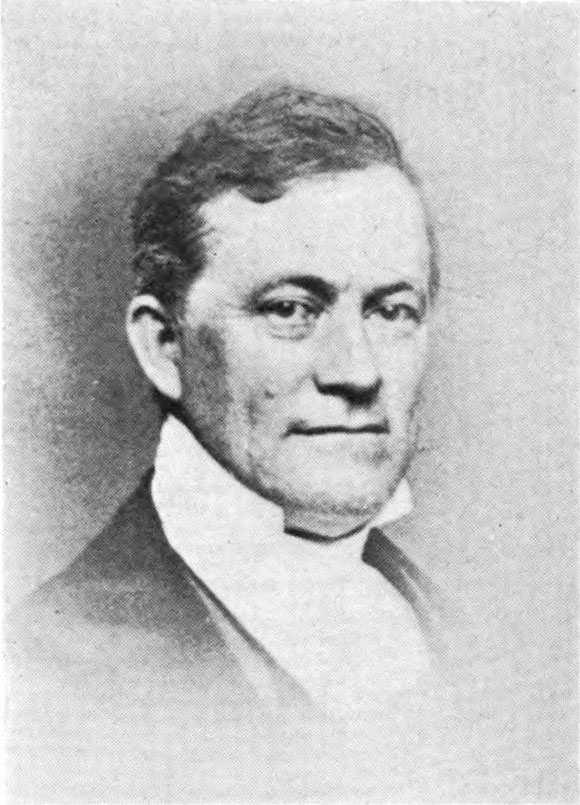 |
|
| portrait from Henry Pynchon Robinson, Guilford Portraits : Memorial epitaphs of Alderbrook and Westside with Introductory Elegies and Essay (New Haven, 1907) | |
Mr. Baldwin had, for several years, been residing with his brother-in-law, William C. Foote of Yonkers, N. Y., and consequently many of the present ministers in active service have never met or known him. His ministry in Connecticut in former years was one of marked diligence and varied activity, and he was prompt and tireless in efforts to do good in the various spheres of usefulness where he labored. A versatile talent and good executive ability fitted him for practical life, and he was an effective preacher, and a careful pastor.
(ex Minutes, 1888)
A. C. Baldwin lived in some obscurity in his last years, but in his active years he had been an ambitious, energetic and productive pastor and writer. His versatile talent
included writing sermons, indexing, lexicography, poetry, and editing. The table below shows his biographical and publication history. A more detailed list of Baldwin (and his wife’s) publications, including links to scans where available, appears at the end of this essay.
| 1804 | Birth of Abraham Chittenden Baldwin, son of Col. Benjamin and Betsy (Chittenden Baldwin) in Guilford, Connecticut. (April 26) | |
| 1827 | Graduated Bowdoin College. | |
| 1830 | Graduated Yale Theological Seminary. | Helen and her Cousin. Written for the American Sunday-school Union. |
| 1830 | Ordained, Berlin, Massachusetts. | |
| 1830 | Married Emily Foote. (June 30) | |
| 1832 | Dismissed. | Sermon preached in the Unitarian Congregational Church in Northborough, at the funeral of Isaac B. Davis : who died, January 7, 1832, aged 22. |
| 1833 | Installed, Olivet Church, Springfield. | The confession of faith adopted by the Evangelical Congregational Church of Berlin, July 29th, 1832. |
| 1839 | Dismissed. | |
| 1839-40 | Principal, Ladies’ Seminary, Newburgh, New York. | |
| 1841 | Themes for the Pulpit, being a collection of nearly three thousand topics with texts... | |
| 1842 | Installed, Howe Street church, New Haven | Essentials of the Gospel : a sermon preached at the dedication of the Church in Howe Street, New Haven, January 26, 1842. |
| 1843 | Awarded Honorary Master of Arts, Yale University | |
| 1845 | Dismissed | |
| 1846 | Review of a pamphlet purporting to be a Statement of facts in relation to the Howe Street Society: containing also additional facts. | |
| 1847-54 | Family guardian,Deaf and Dumb Asylum, Hartford; compelled by ill health in his family to resign this office |
|
| 1848 | Pulpit themes : illustrated by three thousand Scripture tests in full, systematically classified... (Edinburgh edition) | |
| 1853 | The traveler’s vade mecum, or Instantaneous Letter Writer, by mail or telegraph | |
| 1857 | Installed, First Church, Durham | Friendly letters to a Christian slaveholder. The dark ways of God. A sermon preached October 3, 1856, at the funeral of the Rev. Samuel N. Shepard, Pastor of the First Church in Madison, Conn. |
| 1860 | Dismissed | |
| 1861-66 | Acting pastor, Black Rock, Bridgeport | |
| 1862 | The faithful minister’s joy in death : a sermon, preached March 9, 1862, at the funeral of the Rev. David Smith, D.D. | |
| 1866 – | without charge: supplied vacant pulpitsin the Hartford vicinity for about ten years. | |
| 1873 | Joel Barlow.New Englander | |
| 1880 | The frozen zone and its explorers: a comprehensive history of voyages, travels, adventures, disasters, and discoveries in the Arctic regions... (co-author) A pastor’s counsels to young Christians in a series of familiar addresses following a revival of religion. | |
| 1886 | Emily dies. (October 1) | |
| 1887 | A. C. Baldwin dies of the infirmities of age, aggravated by liver and kidney disease,in Yonkers, New York. (July 6) |
Baldwin demonstrated with his Themes for the Pulpit (1841) and Pulpit Themes (1848) an interest in systematic assemblage of ideas and texts. I surmise that his experience at the Deaf and Dumb Asylum in Hartford (1847-54) further encouraged him along these lines. The medium of instruction there was sign language, introduced from France, and whether or not he learned sign, Baldwin would have been exposed to a more theoretical conception of language and communication; that, and perhaps freedom from the weekly grind of generating sermons, may have emboldened him to undertake his ambitious Traveler’s vade mecum. The American Asylum for Deaf-mutes had been established in Hartford in 1816 by Thomas Hopkins Gallaudet (1787-1851, like Baldwin a graduate of Yale’s School of Divinity) and Laurent Clerc (1785-1869), whom Gallaudet had induced to come from France. The archives of the American School of the Deaf are described here. (I need to pursue this direction further.)
Baldwin was competitive. His Friendly Letters
appeared in a collection of prize-winning essays on slavery. His published output of sermons appears to be substantial. His writing was fluent and confident.
Information presented in the table above is derived from several sources, including these :
Vital Statistics
in The Congregational Yearbook, 1888. Boston: Congregational Publishing Society (thanks to Gloria J. Korsman at Andover-Harvard Theological Library for finding and making this available to me)- Minutes of the General Conference of the Congregational Churches of Connecticut, at the Twentieth Annual Meeting, at Middletown, November 8-10, 1887, with Reports and Statistics. Volume IV., 1885-1889 (Hartford, Conn., 1888): 369-70 here
- History of Bowdoin College, with biographical sketches of its graduates, from 1806 to 1878, inclusive (Boston: James Ripley Osgood, 1882) : 363 here
Baldwin is poetically eulogized here : Reverend Abram Chittenden Baldwin,
verse memorial in Henry Pynchon Robinson, Guilford Portraits : Memorial epitaphs of Alderbrook and Westside with Introductory Elegies and Essay (New Haven, 1907) here —
...Much more than theology did he know,
This active brainy man for order made
And function, full executive in grade...
publications
This is not a careful bibliographic guide, rather a chronological listing of items encountered online. With one or two exceptions, it excludes (so far) poetry and brief notices by Baldwin (and his wife) found in the American Periodicals Series, Nineteenth Century Magazines, and in America’s Historical Newspapers.
- Helen and her Cousin.
Written for the American Sunday-School Union. Revised by the Committee of Publication.
1830. 79pp. One in theTen Dollar Sunday-school Library,
listed here and reviewed here. - Sermon preached in the Unitarian Congregational Church in Northborough, at the funeral of Isaac B. Davis : who died, January 7, 1832, aged 22. Publication: Boston : Printed by Pierce and Parker, 1832 (24pp)
- The confession of faith adopted by the Evangelical Congregational Church of Berlin, July 29th, 1832. : Together with the original church covenant. Evangelical Congregational Church (Berlin, Mass.); Boston: : Printed by Peirce & Parker., 1833 (12pp)
- Themes for the Pulpit, being a collection of nearly three thousand topics with texts, suitable for public discourses in the pulpit and lecture room. Mostly compiled from the published works of ancient and modern divines. New York, M. W. Dodd, 1841
The NYPL copy (Google scan) bears no marginalia save for an inscription on the first flyleaf —
Rev. Samuel Miller D.D. / With the Respect of the Compiler.
It also bears a bookplate (or stamp) for theLibrary of Princeton University.
My own copy has a similar inscription, same location, same hand, toJames Milnor D.D.
. - Essentials of the Gospel : a sermon preached at the dedication of the Church in Howe Street, New Haven, January 26, 1842. New Haven, Conn.: Printed by B.L. Hamlen, 1842 (26p)
- Review of a pamphlet purporting to be
a Statement of facts in relation to the Howe Street Society
: containing also additional facts. New Haven : Printed by B.L. Hamlen, 1846.
n.b.:
This and two related items are listed in Henry Martyn Dexter, The Congregationalism of the last three hundred years, as seen in its literature: with special reference to certain recondite, neglected, or disputed passages, &, &. (New York, 1880) here. The other two items, one preceding and the other succeeding Baldwin’s own, are :
Statement of Facts in Relation to the Howe-Street Society. New Haven, 1846. octavo, pp. 14.; and
The Reviewer reviewed: being an Examination of a Pamphlet published by the Rev. A. C. Baldwin,purporting
to be a Review of a Statement of Facts, etc. New Haven, 1846. octavo, pp. 38. - Pulpit themes : illustrated by three thousand Scripture texts in full, systematically classified from the works of the most eminent divines. Edinburgh: R. Ogle and Oliver & Boyd, 1848
- The traveler’s vade mecum, or Instantaneous Letter Writer, by mail or telegraph, for the convenience of persons traveling on business or for pleasure, and for others, whereby a vast amount of time, labor, and trouble is saved. New York: A.S. Barnes & Co., 1853
Friendly letters to a Christian slaveholder,
in Liberty or slavery; the great national question (Three prize essays on American slavery.
Boston, Congregational board of publication, 1857.
(The other contributions are Richard Bowers Thurston (1819-1895),The error and the duty in regard to slavery,
and Timothy Williston (-1893),Is American slavery an institution which Christianity sanctions, and will perpetuate?
)- The dark ways of God. A sermon preached October 3, 1856, at the funeral of the Rev. Samuel N. Shepard, Pastor of the First Church in Madison, Conn., who died September 30th, 1856, aged fifty-seven. New York: : John F. Trow, printer, 1857 (23pp)
- The faithful minister’s joy in death : a sermon, preached March 9, 1862, at the funeral of the Rev. David Smith, D.D., for thirty-three years pastor of the church in Durham, Conn., who died March 5th, 1862, aged ninety-four.New York : J.P. Prall, 1862. (46pp)
Joel Barlow.
New Englander ( July 1873): 413-37.
Barlow (1755-1812) was apoet and patriot,
who had served as chaplain in Washington’s army, and went to France on a trade-diplomatic mission. He was proceeding to meet Napoleon, then on his ill-conceived advance into Russia, when he died in Poland.
Baldwin’s writing is fluent. I fasten on this passage, for example :Something must be done. Just at this crisis, one of those dashing, brilliant humbugs, which about once in twenty years have from time immemorial bedazzled and duped the public with promises of large and sudden wealth to all its patrons, was brought out from its infernal den, where such things are concocted by the knowing ones, and attracted almost universal attention. It was a great
(p421)Land Company
...
Two observations: his use of the expressionthe knowing ones,
that one recalls (Lord) Timothy Dexter his A Pickle for the knowing ones: or, Plain truths in a homespun dress (1838, reprinted in Boston 1881) here, and his energetic language about humbugs, familiar to us from his Traveler’s vade mecum.Fitz-Greene Halleck and the Village Belle
, in Harpers (June 1878): 132-3
For more than half a century the writer has had in manuscript a copy of a humorous poetical correspondence between Halleck and an interesting, talented young lady of Guilford, Connecticut, the native place of each...
An introduction is followed by the poetry itself.
No particulars are given about thetalented young lady
save that she was the beautiful and bright daughter ofone of the most respected and honored families in the State
andfell a victim to consumption in early life.
Baldwin presumably knew her. Fitz-Greene Halleck (1790-1867) was a well-regarded poet of his time.- A pastor’s counsels to young Christians in a series of familiar addresses following a revival of religion. Boston: Congregational Publishing Society, 1880.
- The frozen zone and its explorers: a comprehensive history of voyages, travels, adventures, disasters, and discoveries in the Arctic regions, including recent German and Swedish expeditions; Captain Nare’s English expedition; Prof. Nordenskiold’s discovery of a northeast passage; the sailing of the Jeannette, etc. Illustrated with one hundred and seventy-five engravings and maps. Written and comp. from authentic sources, by Alexander Hyde, A.M., Rev. A.C. Baldwin and Rev. W.L. Gage. (Hartford, Conn., R.W. Bliss & company; San Francisco, Cal., A.L. Bancroft & co., 1880)
Mrs. Baldwin seems to have been the author of these volumes, as well :
- The turkies’ convention; and The gander’s protest. [N.p., 1874] (at Yale)
- Ruined by rum.: A tale of facts; together with an appeal for temperance./ By a lady. Hartford: Brown & Gross [etc.], 1877. (at Michigan)
Both A. C. and Mrs. Baldwin published poetry, and A. C. some other short items, in periodicals including Christian Secretary and the New York Observer and Chronicle during the 1870s. At some point I will transcribe Mrs. Baldwin’s The Parson of Olden Times and the Modern Parson. A Ballad.
from the Christian Secretary, April 6, 1876. It’s pretty good.
20100610, reformatted 20131026